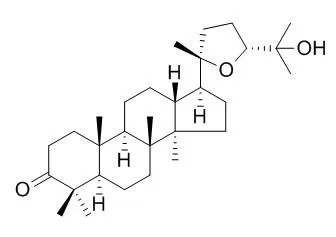| In vitro: |
| Z Naturforsch C. 2011 May-Jun;66(5-6):245-50. | | Effect of triterpenoids and limonoids isolated from Cabralea canjerana and Carapa guianensis (Meliaceae) against Spodoptera frugiperda (J. E. Smith).[Pubmed: 21812341] |
METHODS AND RESULTS:
The activities of two triterpenoids, Ocotillone and cabraleadiol, and four limonoids, methyl angolensate, 3-beta-deacetylfissinolide, 7-deacetoxy-7-oxogedunin, and beta-photogedunin, isolated from arillus of Carapa guianensis and fruits and seeds of Cabralea canjerana (Meliaceae), were evaluated against the fall armyworm Spodoptera frugiperda. Gedunin was used as a positive control.
CONCLUSIONS:
7-Deacetoxy-7-oxogedunin and beta-photogedunin reduced the pupal weight as occurred with gedunin. Cabraleadiol, 3-beta-deacetylfissinolide, and 7-deacetoxy-7-oxogedunin prolonged the larval phase similar to the control (gedunin) of approximately 1.2 days at 50.0 mg kg(-1). The highest insecticidal activity was obtained for beta-photogedunin. | | J. Microbial. Biotechnol.,2002,12(5):854-7. | | Antimicrobial effects of ocotillone isolated from stem bark of Ailanthus altisshima.[Reference: WebLink] |
METHODS AND RESULTS:
Bioassay-directed chromatographic fractionation of a methylene chloride extract of Ailanthus altisshima indicated the presence of 20(S), 24(R), epoxy-25-hydroxydammarane-3-one (compound 1, Ocotillone) which was isolated from this plant, for the first time. Antimicrobial activity of compound 1 was measured by inhibition of bacterial and fungal cells growth and by a hemolytic assay with human erythrocytes, respectively. The results revealed that compound 1 had potent antibacterial activity against Gram-negative bacteria, P. aeruginosa and S. typhimurium, that were without hemolytic activity, whereas it had weak antimicrobial activity against Gram-positive bacteria and fungi.
CONCLUSIONS:
These results demonstrated that the compound 1 has more antibacterial activity against Gram-negative bacteria, which have no hemolytic activity, than Gram-positive bacteria and fungi. This is the first report on the biological activities of the compound 1. |
|






 Cell. 2018 Jan 11;172(1-2):249-261.e12. doi: 10.1016/j.cell.2017.12.019.IF=36.216(2019)
Cell. 2018 Jan 11;172(1-2):249-261.e12. doi: 10.1016/j.cell.2017.12.019.IF=36.216(2019) Cell Metab. 2020 Mar 3;31(3):534-548.e5. doi: 10.1016/j.cmet.2020.01.002.IF=22.415(2019)
Cell Metab. 2020 Mar 3;31(3):534-548.e5. doi: 10.1016/j.cmet.2020.01.002.IF=22.415(2019) Mol Cell. 2017 Nov 16;68(4):673-685.e6. doi: 10.1016/j.molcel.2017.10.022.IF=14.548(2019)
Mol Cell. 2017 Nov 16;68(4):673-685.e6. doi: 10.1016/j.molcel.2017.10.022.IF=14.548(2019)